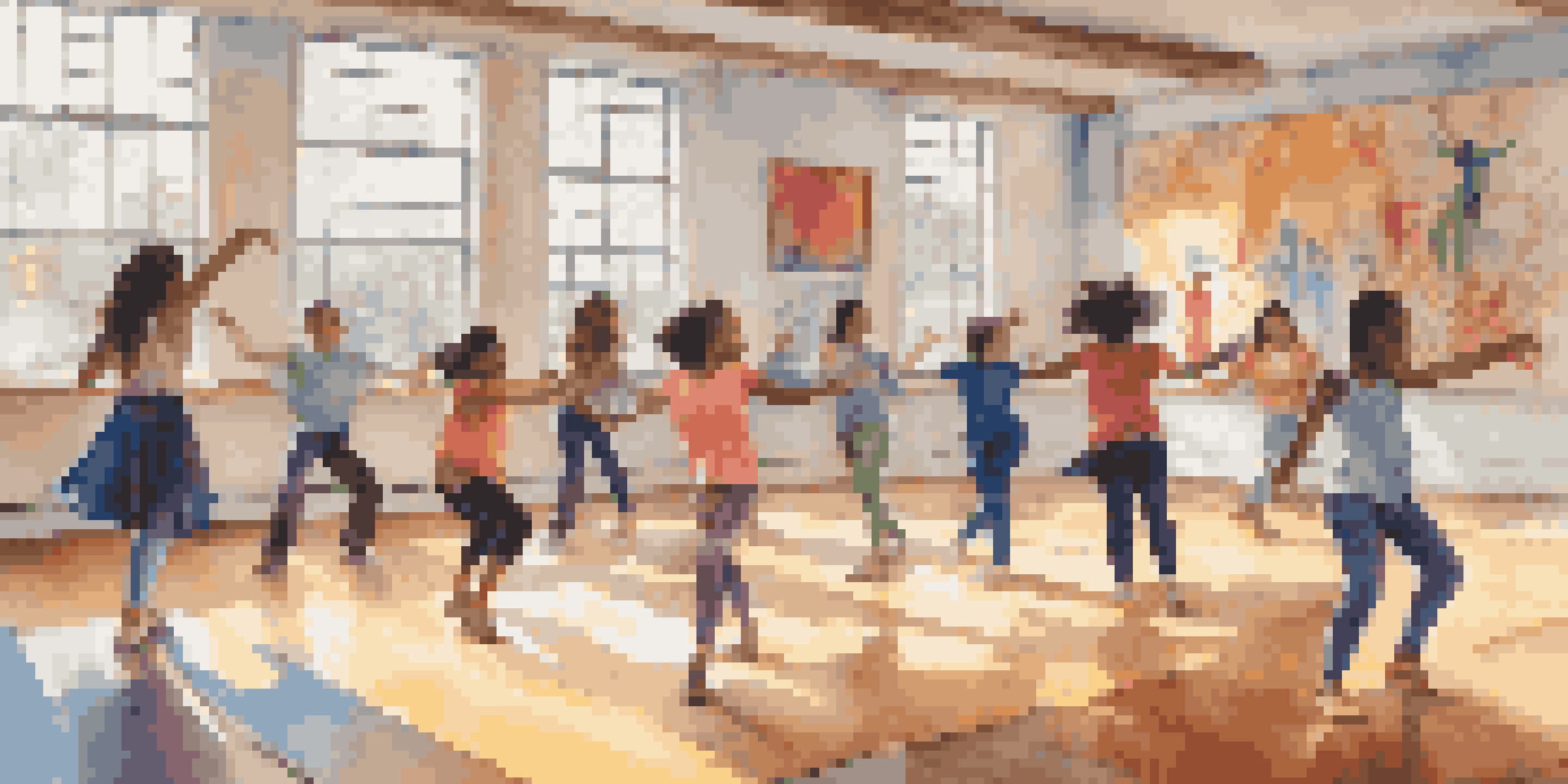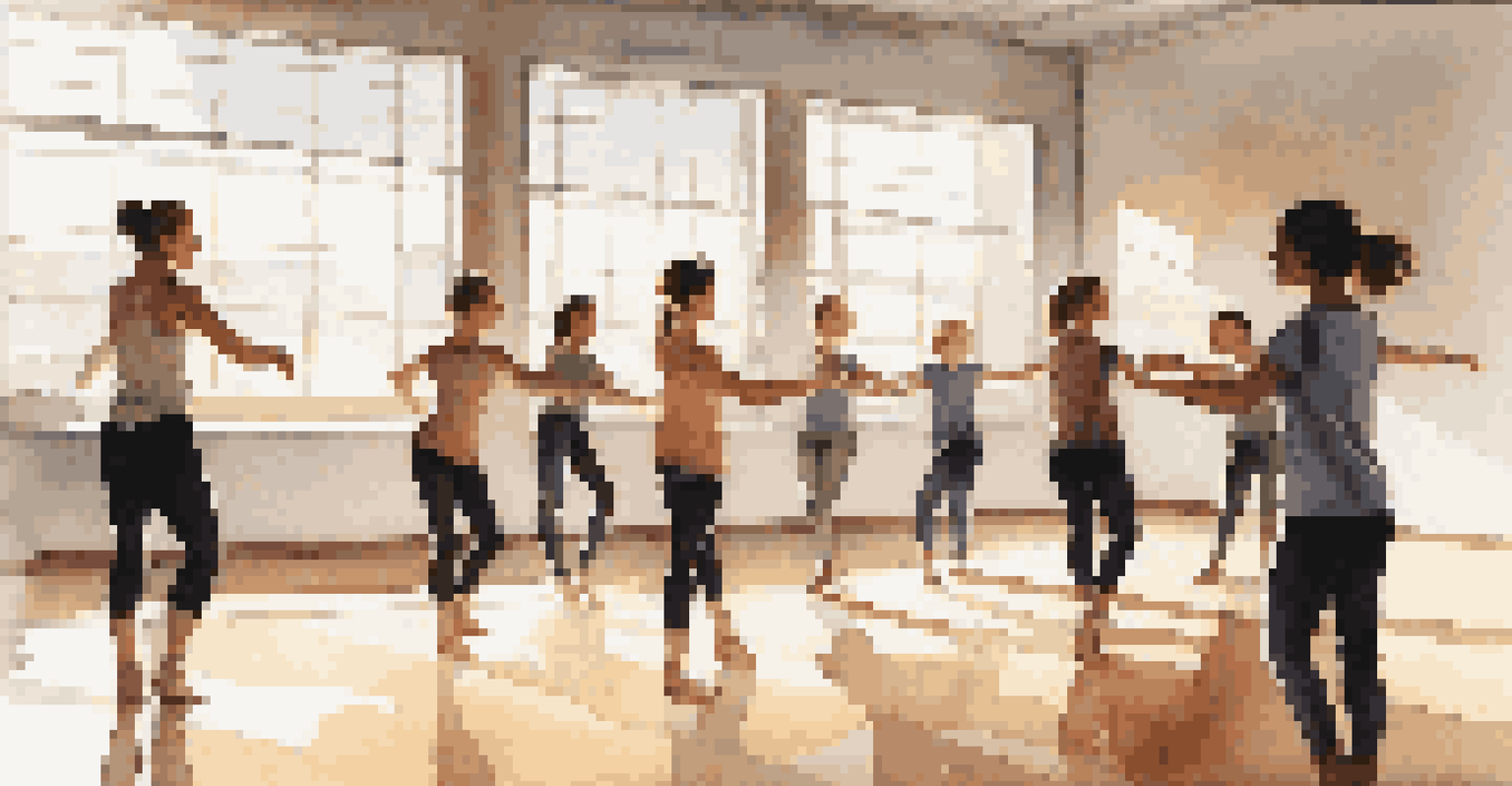Empowering Students through Dance Pedagogy Techniques

Understanding Dance Pedagogy and Its Importance
Dance pedagogy is the art and science of teaching dance, emphasizing not just movement but also creativity and expression. It fosters a learning environment where students can explore their emotions and develop their physical skills. By integrating dance into educational settings, we can enhance students' overall learning experiences.
Dance is the hidden language of the soul.
This approach encourages students to take ownership of their learning, allowing them to express themselves in unique ways. It also nurtures critical thinking and problem-solving skills, which are essential in today’s fast-paced world. When students engage with dance, they learn to communicate and collaborate, building a sense of community within the classroom.
Ultimately, understanding dance pedagogy helps educators create a more inclusive and dynamic learning environment. By valuing each student's individuality and creativity, we can empower them to thrive both in and out of the classroom.
Key Techniques in Dance Pedagogy
Several techniques are foundational to effective dance pedagogy, including improvisation, choreography, and somatic practices. Improvisation allows students to explore movement freely, fostering creativity and self-expression. This form of unstructured dance can lead to a deeper understanding of their bodies and their artistic intentions.

Choreography, on the other hand, teaches students the importance of structure and collaboration. By working together to create a dance piece, they learn to communicate ideas and embrace diverse perspectives. Somatic practices focus on body awareness, encouraging students to develop a mindful connection to their physical selves.
Empowerment Through Dance Education
Dance pedagogy fosters creativity, self-expression, and critical thinking, empowering students both in and out of the classroom.
These techniques not only enhance students' dance skills but also contribute to their holistic development. By incorporating these methods into the curriculum, educators can cultivate an environment that supports creativity and personal growth.
Creating a Safe and Supportive Environment
A crucial aspect of empowering students through dance is establishing a safe and supportive environment. This ensures that students feel comfortable expressing themselves without fear of judgment. When they know their ideas and movements are valued, they are more likely to take risks and explore their creativity.
The only way to do great work is to love what you do.
Instructors can foster this environment by setting clear expectations and encouraging positive feedback among peers. Celebrating each other's successes, no matter how small, builds a sense of belonging and camaraderie. This supportive culture allows students to step outside their comfort zones and engage more fully in the learning process.
Ultimately, a nurturing environment not only enhances students' confidence in dance but also in their overall academic pursuits. When they feel empowered in dance, they are likely to carry that confidence into other areas of their lives.
Integrating Technology in Dance Education
In today’s digital age, integrating technology into dance pedagogy can enhance the learning experience. Tools like video analysis, digital collaboration platforms, and virtual classes can provide students with new ways to engage with dance. These resources can also make dance education more accessible to a wider audience.
For example, using video analysis allows students to review their movements and receive constructive feedback. It helps them understand their strengths and areas for improvement, which can lead to greater self-awareness. Digital platforms enable students to collaborate on choreography, breaking down geographical barriers and fostering a sense of global community.
Collaboration Enhances Learning
Working together in dance helps students develop teamwork skills, empathy, and social awareness, which are essential for personal and professional growth.
However, it’s essential to strike a balance between technology and traditional dance practices. While technology offers valuable tools, the essence of dance lies in human connection and expression, which should remain at the forefront of dance education.
Fostering Collaboration Through Dance
Collaboration is a key component of dance pedagogy, encouraging students to work together toward a common goal. Group projects, such as creating a dance piece or participating in ensemble work, help students develop teamwork skills. They learn to communicate effectively, compromise, and appreciate diverse viewpoints.
Furthermore, collaborating in dance fosters empathy and social awareness. Students become more attuned to their peers' needs and feelings, which can translate into stronger relationships outside of the dance studio. This sense of community is vital in creating a supportive learning environment.
Through collaboration, students not only enhance their dance skills but also develop invaluable life skills. The ability to work well with others is essential in any field, making dance a powerful tool for personal and professional development.
Encouraging Self-Reflection and Growth
Self-reflection is an integral part of the learning process in dance education. Encouraging students to assess their performances and progress helps them identify their strengths and areas for growth. This practice cultivates a growth mindset, empowering them to view challenges as opportunities for improvement.
Instructors can facilitate this process by incorporating journaling or group discussions into the curriculum. Students can share their experiences, insights, and personal goals, fostering a sense of accountability. This reflection not only deepens their understanding of dance but also encourages personal development.
Self-Reflection Drives Growth
Encouraging self-reflection in dance allows students to identify strengths and areas for improvement, fostering resilience and a growth mindset.
Ultimately, self-reflection enables students to take ownership of their learning journey. By recognizing their progress and setting new goals, they become more resilient and motivated individuals, ready to tackle any challenge that comes their way.
The Lasting Impact of Dance Pedagogy
The benefits of dance pedagogy extend far beyond the dance studio, influencing students' lives in myriad ways. The skills they develop—creativity, collaboration, self-discipline—are transferable to various aspects of their personal and academic lives. Dance education equips students with tools that foster resilience and adaptability in an ever-changing world.
Moreover, the sense of community built through dance often leads to lasting friendships and support networks. Students who engage in dance are more likely to feel connected to their peers, contributing to a positive school culture. This sense of belonging can significantly impact their overall well-being and academic success.

In conclusion, empowering students through dance pedagogy techniques is a transformative process that nurtures their creative potential and personal growth. By embracing this approach, educators can inspire the next generation to thrive both in dance and in life.